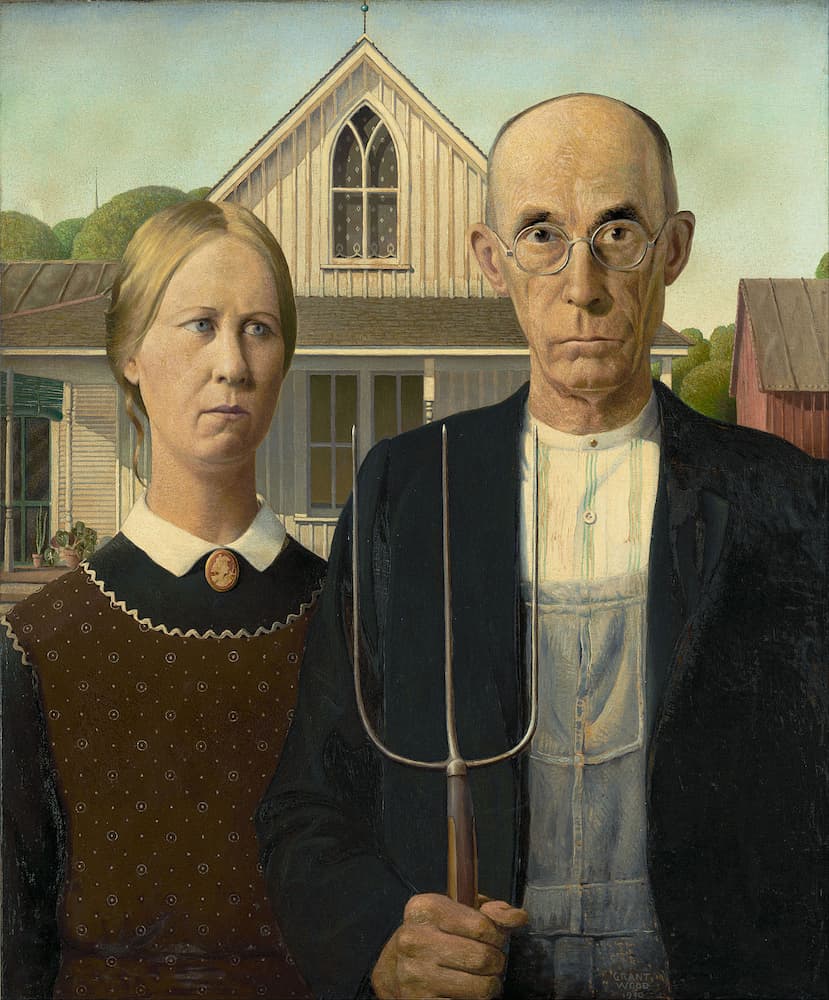Regionalism is a subgenre of American Scene Painting, and was the defining artistic style of the American Midwest from the late 1920s through until the 1940s (the other genre of American Scene Painting was Social Realism, inspired by the French Barbizon School).
Coinciding with the Great Depression, the movement is often saturated by political undertones, highlighting the problems of a crumbling economy and crippling unemployment. It idealised the rural work ethic, and rejected the incessant urbanisation taking place across the country.
The movement encompassed many artists but was defined by three: Grant Wood, Thomas Hart Benton, and John Steuart Curry. Some art historians would include Edward Hopper, whose work has many of the same motives as Regionalism, but he is more often associated with Realism.
The movement depicted humble American towns, rural landscapes, and toiling labourers as a reaction against European artists defining taste and trends in the artworld, which were rapidly moving towards Abstractionism. Regionalist artists felt that realistic depictions of the American landscape were the only way to make art accessible to everyday Americans.
Regionalism is not defined by its style, but rather its subject. All of the defining artists of the period had vastly different artistic techniques, but were united in their approach to depicting the humble and working-class Midwest. Their approach to landscape painting was inspired by earlier North American movements such as The Hudson River School, who championed the American landscape through a Romantic, European lens.
Grant Wood
You may not know his name, but you will definitely know his most famous painting: ‘American Gothic’ is a portrait of a two rather stern-looking Americans located outside a Gothic-inspired wooden building; the man is holding a pitchfork whilst the woman (who is actually his daughter), stands behind him. Wood painted the family he imaged would live in such a house, with both the people and the architecture typifying 20th-century rural Americana.
This painting, amongst others, sums up the contradicting title for this blog post. Everyone knows this artwork, however few people are aware of Regionalims as a movement, or what it stands for.
Thomas Hart Benton
Benton’s work is fluid and sculptural, with strong visual links to the work of Surrealists and Metaphysical painters, despite their foreign influence. Having studied in Paris and New York, Benton became a self-declared “enemy of modernism”. He was born in Missouri, and as an artist he strived to depict the Midwest, but his most successful works feature the east-coast island of Martha’s Vineyard, and the small town of Chilmark.
John Steuart Curry
Curry was born in Kansas in 1897, and frequently painted his home state, depicting farm life, prairie fires, tornadoes, and the violent Bleeding Kansas period. In the 1930s, he painted the mural ‘Tragic Prelude’ in the Kansas State Capitol building, which featured the Abolitionist John Brown between Unionist and Confederate soldiers, standing in front of tornadoes and prairie fires.
Across Kansas, Curry’s work was received with disgust; his paintings portrayed a backwards, out-of-date State troubled by lingering resentment from the Civil War, poor agricultural management that caused the Dust Bowl of the 1930s, and backbreaking rural labour. Curry simply painted what he saw.
Regionalism is an interesting movement: it is simultaneously world-famous and obscure. Clearly, Grant Wood’s ‘American Gothic’ is to thank for the movement’s fame, but what is it about that painting that has inspired a generation of studies, exhibitions, and parodies (which happen to have their own dedicated website…)?
It is certainly not a beautiful painting. Nor is it a controversial one. Wood himself said that it is somehow satirical, but he didn’t really elaborate.
And maybe it’s the ambiguity that makes the painting so successful: its adaptable meaning for different people in different places, be it satire, or humor, or just a celebration of good ol’ Midwestern farm folk. Every single person takes something different from it, and that is what makes Regionalism great.




